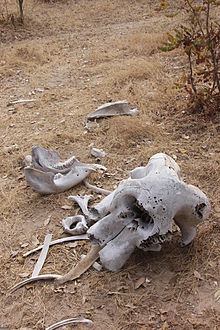Elephants' graveyard

An elephants' graveyard (also called elephant graveyard, elephant's graveyard, or elephants' cemetery) is a place where, according to legend, old elephants instinctively direct themselves when they reach a certain age.[1] According to this legend, these elephants would then die there alone, far from the group. However, there is no evidence in support of the existence of the elephants' graveyard.[2]
Origin
Several theories have been proposed to explain the origin of this myth. One theory involves people finding groups of elephant skeletons together, or observing old elephants and skeletons in the same habitat.[3] Others suggest the term may spring from group die-offs, such as one excavated in Saxony-Anhalt, which had 27 Palaeoloxodon antiquus skeletons.[4] In that particular case, the tusks of the skeletons were missing, which indicated either hunters killed a group of elephants in one spot, or else opportunistic scavengers removed the tusks from a natural die-off.[citation needed]
Other theories focus on elephant behavior during lean times, suggesting starving or elderly elephants who have worn their teeth down to a point that they can no longer chew tougher foods gather in places where finding food is easier, and subsequently die there.[5] Prolific elephant hunter Walter "Karamojo" Bell discounted the idea of the elephant's graveyard, stating that bones and "tusks were still lying about in the bush where they had lain for years".[6]
Popular culture
The idea of an elephant graveyard first appeared in popular culture with Sir Rider Haggard's The Ivory Child (1916), the twelfth of the eighteen Allan Quatermain adventures.
The idea of a graveyard for elephants was popularized in films such as Trader Horn and MGM's Tarzan films, in which groups of greedy explorers attempt to locate the elephants' graveyard, on the fictional Mutia Escarpment, in search of its riches of ivory.[7]
Disney's 1994 animated musical film The Lion King has a reference to this motif, as well as its musical adaptation, video game adaptation, and the 2019 remake of the film.
Derivative meanings
- In geology, "elephants' graveyard" is an informal term for a hypothetical accumulation of "large blocks of country rock stoped from the roofs of batholiths".[8]
- In military settings, it is sometimes used as a slang term to describe postings or assignments for senior officers for whom there is no potential for further promotion.[citation needed]
- In Spain, the Spanish Senate is often criticised as a cementerio de elefantes where politicians who have lost their previous positions end up doing no productive work.[9]
- It is a term for the offices and a secretary provided to former high-ranking executives of large companies (at least in the United States), who have either retired or resigned. An executive who relinquishes or is relieved of authority becomes a consultant (special adviser) where they continue to receive a salary and an office under their contract but have little or no actual responsibilities until their non-compete agreement expires.[10]
Additionally the term "elephants' graveyard" has been deliberately used in a symbolic fashion to refer to specific paleontological sites, such as the elephant-fossil deposit that René Jeannel, professor at the French National Museum of Natural History, discovered during a Kenya & Ethiopia expedition in 1932.[11]
See also
- Elephant cognition and reports of elephant death rituals.
References
- ^ Young, Rory (November 15, 2013). "Do Elephant Graveyards Exist?". Slate. Retrieved February 3, 2018.
- ^ "The elephants' graveyard: Protecting Kenya's wildlife". BBC News. 2014-06-01. Retrieved 2021-10-02.
- ^ Armitage, Kenneth B.; Buss, Irven O. (March 1992). "The Great Beast — Elephant Life: Fifteen Years of High Population Density". BioScience. 42 (3). BioScience, Vol. 42, No. 3: 196–197. doi:10.2307/1311827. hdl:1808/10608. JSTOR 1311827.
- ^ Brühl, Enrico; Mania, Dietrich (22–25 September 2003). "Neumark-Nord: a middle Pleistocene lake shore with synchronous sites of different functional character". Données récentes sur les modalités de peuplement en Europe au Paléolithique inférieur et moyen. Rennes: Université de Rennes.
- ^ Iain Douglas-Hamilton, Richard Barnes, Hezy Shoshani, A. Christy Williams, A. J. T. Johnsingh, Robin Beck, Katy Payne "Elephants" The Encyclopedia of Mammals. Ed. David W. Macdonald. Oxford University Press, 2007. Oxford Reference Online. Oxford University Press. 28 August 2007
- ^ Bell, Walter (1949). Karamojo Safari. Harcourt, Brace. p. 26. ISBN 1-57157-358-5.
- ^ Earnhart, Brady (1 July 2007). "A Colony of the Imagination: Vicarious Spectatorship in MGM's Early Tarzan Talkies". Quarterly Review of Film and Video. 24 (4): 341–352. doi:10.1080/10509200500526778. S2CID 194054571.
- ^ Clarke, D. Barrie; Henry, Andrew S.; White, Mary Anne (10 September 1998). "Exploding xenoliths and the absence of 'elephants' graveyards' in granite batholiths". Journal of Structural Geology. 20 (9–10): 1325–1343. Bibcode:1998JSG....20.1325C. doi:10.1016/S0191-8141(98)00082-0.
- ^ (in Spanish) PP y PSOE se echan en cara que utilicen el Senado como cementerio de elefantes, Juan Carlos Merino, 7 July 2015, La Vanguardia.
- ^ Dominus, Susan (October 3, 2012). "The Woman Who Took the Fall for JPMorgan Chase". New York Times. Retrieved May 9, 2016.
- ^ René Jeannel, Mission scientifique de l'Omo. Un cimetière d'éléphants avec 48 planches de photographies et une carte hors texte, Paris, publisher: Société des Amis du Muséum, 1934, in-8, sofcover (270 x 185 mm), 159 pp, ASIN B0000DSYFT (in French)
External links
- Teeth, second dentition, tusks – Contains information about the relevance of elephant teeth to the elephant graveyard myth
